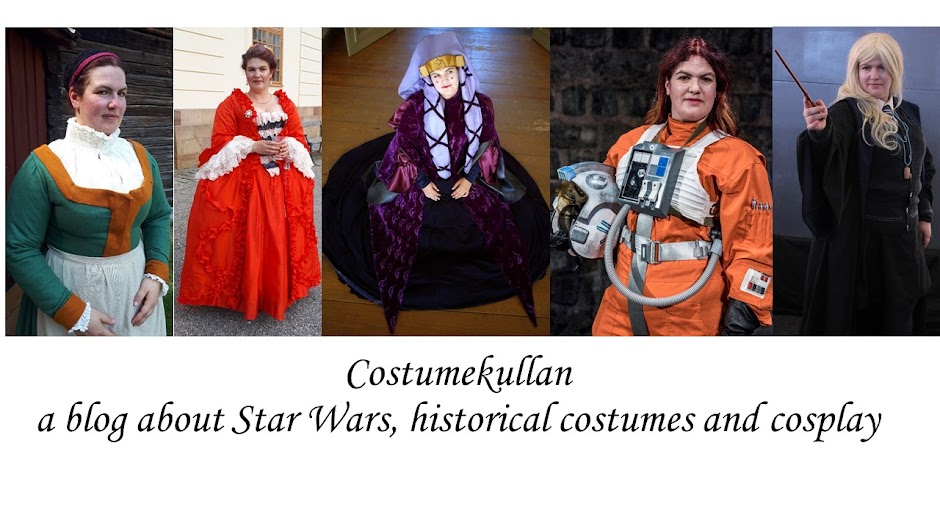The Historical Sew Monthly (HSM) has been part of my regular costuming ever since it actually was the Historical Sew Fortnightly. This year there are quite a few changes. One of them is that there is a general theme - sustainability.
With every challenge we’re celebrating the way fabric & thread were used, honoured, cherished, and re-used in the past. We’re also trying to lessen the carbon footprint of historical costuming, but creating with intent, and re-using whenever possible.
I think it's a good thing to try and be as sustainable as possible, and I will try to follow it and make use of my stash as much as I can.
Another change is that even if there are still 12 challenges, it is up to you to pick when you do the challenge, and they are open the whole year. I still think I will try to tie the challenges to a specific month, it's a good incentive for me to make things, but it's good that I can go back, or if I finish something before the set date I can still use it.
Here are this year's challenges.
January: Timetravelling Garments: Create an item that works for more than one historical era, or that can be used for both historical costuming, and modern wear. It could be an apron that could do 1770s or 1860s in a pinch, a shift that can work under many decades of fashion, or a historical cape you also wear everyday, etc.
We are well into January, and I haven't come up with anything for this. Or rather nothing that I need or would use. Since the overall theme is sustainability I don't want to make things just for making them, and then never use them.
February: Re-Use: Use thrifted materials or old garments or bedlinen to make a new garment. Mend, re-shape or re-trim an existing garment to prolong its life.
No idea yet
March: Green: Make something in a shade or shades of green. If you can also make it ‘green’ in the figurative sense, even better!
No idea yet
April: Local: Support your local industry and your local history by making something that (as much as possible) uses materials made locally, or purchased from local suppliers, or that features a garment specific to your part of the world.
Here I just need to decide what my definition of "local" is, it gets a lot easier if I include Sweden, and not just my area. As I say every year, I always have parts for my folk costume that I can make, and this would fit that challenge.
May: Basic: Make a garment that can be used for many occasions (like a shift, or the classic ‘Regency white dress’), or a simple accessory that will help you stretch the use of an already existing garment.
No idea yet
June: It’s Only Natural: Make something inspired by nature, or use natural fibres and materials in a way that stretches your usual practice (e.g. natural dyeing, using cane instead of plastic whalebone for corsets/stays etc.). Or challenge yourself and do both!
No idea yet - but first weekend of June is the Leksand Medieval fair, and if I'm doing something new for that I could try and fit the challenge.
July: No-Buy: Make something without buying anything. Whether it’s finishing off a UFO, using up scraps of fabric from earlier challenges in the year, sewing entirely from stash, or finding the perfect project for those small balls of yarn, this is your opportunity to get creative without acquiring more stuff.
No idea yetAugust: Celebration: Make something for a specific historical celebration, make something generally celebration worthy, make something that celebrates a historical hero, or just make something that celebrates some new skills you’ve learned.
My 1520s court gown will fit this on so many levels.
September: Sewing Secrets: Hide something in your sewing, whether it is an almost invisible mend, a make-do or unexpected material, a secret pocket, a false fastening or front, or a concealed message (such as a political or moral allegiance).
No idea
October: Get Crafty: Make use of your own skills or learn a new one to make something from scratch rather than buy material. The possibilities for learning and applying new skills and techniques are endless. Lace, pleated self-fabric trim, knotted fly trim, embroidery, dyeing, knitting your own corset laces, hand painting your own fabric...
No idea - but I could always use more lucet cord
November: Go Green Glow-Up: Be environmentally friendly and celebrate how your making skills have ‘glowed-up’ as you’ve used and practiced them by taking apart an early make of yours that no-longer represents your making skills, and re-making it so you’d be proud to use it. It can be as elaborate as a total re-make, or as simple as getting the ribbons or buttons you didn’t have time to source at first. You could even take something from a challenge made earlier in the year, and fix the tiny things you weren’t totally happy with.
I have two options here already. My pink 18th century skirts, or rather the pieces of it since I scrapped it earlier this year, or remake the embroider on my highnecked 16th century shift.
December: Community: It is the season of giving. Create an item that honours or supports the communities around you, whether Real Life or online
No idea yet
As you can see I don't have many firm plans for the challenges, but will probably come up with ideas later on. Last year I didn't finish many challenges, and I think it would be really fun if I could finish all 12 again.











































